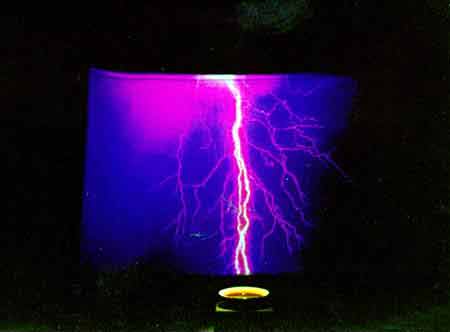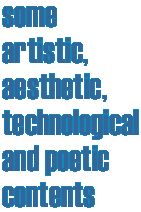the
presence of
interactive systems changes the perception of the world in the digital
era. The human practices related to computers and interfaces, their
hardware and software provide us some different sensitive moments in
biological and emotional aspects. Interactive art explores the behaviour
of human bodies and the behaviour of the artificial systems, offering
ephemeral connections during people's relationship with technologies
and modifies the cultural scene. The main goal is to provoke the dialogue
of natural and artificial systems, using technologies to offer their
aesthetic dimension. Artistic creations improve enhancing the field
of perception, offering other limits for the interfaced body's actions.
In the Cyberart context, the sujet interfacé1 radically
modifies the situation of the viewer of a painting, a photography, a
film, a video and other art media. When human/environment relationship
is gradually been done in the cyberspace, the space of computers and
networks, their interfaces, architecture and softwares, we live in a
technoenvironment or cyberenvironment having other synaesthetic effects
provoked by the hybridization of the body and the artificial system.
Cyberartists,
being aware of an anthropological revolution from technologies'effects
on human social relationships, program the sensitive of complex system
not to represent worlds, but to simulate other kinds of worlds. The
paradigm of representation, the idea of the beautiful, the contemplation
of an image or an object are changed by fields of relation between bodies
and computers, among networks, among several bodies connected, amplified,
distributed in planetary dimensions, between minds and softwares, in
agent minds and agents for the minds. In the process, what matters is
interacting, dialoguing, and sharing with internal and external worlds.
With interactive art, the idea of closed representation, as the ultimate
reality shaped on an object, is no longer valid.
The
pre-given exterior world, the closed representations of a painting,
an engraving, a video, a sculpture contrast their truths stuck on their
supports with the mutability of interactive art. Artists provoke the
fall of the sovereignty of the interior I changed by a distributed,
connected, networked I, immersed in artificial worlds and determining
an augmented, expanded reality. What matters is to attempt conscioussnes'propagations
by interacting or acting in and with. To interact demands a total implication
with the situation proposed and it presupposes a state of "attentiveness".
Interactive art interrogates the existence as a possibility of constantly
reinventing life. Vigilance, receptivity, choice, collaboration, control,
reenframements, during states of unpredictability, chances, disorders,
adaptability among other sensitive moments for those who foresee an
interactive system. The connections offer ways of feeling mixing artificial
and natural, real and virtual, carbon and silycium, organic and inorganic.
Computer
simulations and perceptions arise from interaction and validates the
principle of connectivity and the emergency of interactive technologies.
Artists have been exploring the dialogue with technologies, aesthetisizing
them in order to propose a kind of art in dynamic activities, non hierarchical
contexts, which accepts the theories of the agents with which we branch
off in search of information, in the artificial intelligence of networks
and in every situation proposed by scientific advances responding to
the new forms of creation provided by technologies. Creations amplifie
the ways of feeling if compared with the art of matter wich separates
and isolates the viewer from the artistic object. Paintings, sculptures,
drawings determine these separations, and the contemplation and interpretation
are made by an I which does not acts and modifie physically the structure
matter of art. How can we act in images of a painting, in the texture
of a sculpture and exchange with them different states? The art which
uses support and materials has dimensions, weight, defined and unchangeable.
In this kind of art exterior and interior are definitely marked. We
are not allowed to exchange information as it happens with memory units
we share with the cyberspace and that put the artistic object in situations
of mutation.
Artists
work in collaboration with scientists and technicians and explore the
behaviour of systems. They attempt at facing hardware and software challenges
in order to create interactivity beyond the mouse, the keyboard and
the screen. They see the computer as a complex system and no longer
as a tool or a mere machine. Interactive artistic works amplifie the
representation of nature and phenomena as the excellent examples given
from Leonardo, Poussin, Turner, or the cinetisme's possibilities opened
by Calder, Tinguely, or the attitudes of participation of Le Parc, Sotto,
Oiticica, Lygia Clark. Interactivity allow us to work with the invisible
forces and process them, generating fluxes of life, its language and
laws connected to the language of cyberspace. Heat, noises, breath,
brain waves, voice, touch and other signals of the world connections
are programmed by artist's intentions creating systems to generate complex
relations where microstructure units regenerate. What arises with the
computer are simulated realities , rated from language and calculations,
complex operations, intelligent objects, computer networks, virtual
environments, multiusers collaborative worlds, robotic bodies and events,
artificial life, virtual reality, intelligent agents, avatars as characters
we incorporate or other artificial worlds. Different kinds and levels
of interactivity can be developed. The creation dialogues with database
and establishes the connectivity between machines and humans, processing
information in real time and generating states of emergency.
The
mutability principle, the come-into-being governs creation in Cyberart.
Synthetic worlds, hypermedia structures and associative process of CD
ROMs and websites, mutations of interactive objects and installations,
collaborative spaces in the web, the telepresence and remote actions
in telerobotics spaces or no matter which domain and type of creation
with interactive technologies always stress the aesthetic dimension
of interactive art. The principles governing creation are mutability,
ephemerity, come-into-being in processes, which demand reciprocity,
collaboration, shared relationships for the one, which was the viewer
of previous artistic manifestations.
| structural
copulae and interval zones |
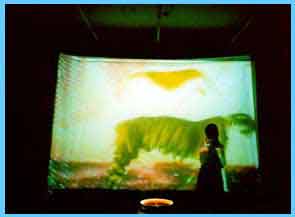 Interactive
art is the art of events (Costa: 1994). The body is involved in events
or in eventual and ephemeral situations, fluxes of life, demanding the
existence of the body and its performance. The bodies'actions create
an interval zone where something will happen in that exact moment, because
a body is acting with an interactive system. We inhabit "interval zones",
between the body and the technologies. Every artistic proposal puts
closer art and life and implies metamorphosis and vital process of art
experience. Interfaces put artists just in the middle of the participant's
process and they need to offer a system to be provoked by people actions.
Artists need to imagine what kind of life they would want people experience
during the real time flow. The sensitive apparatus is immersed in constructive
processes. It is not only the case of generating knowledge and to fix
it on a memory as the given result, but of evolving in mental processes
of a technical nature and a human nature. We are coupled, connected
and reaffirm the environment's vital regenerating processes. Interactive
art is the art of events (Costa: 1994). The body is involved in events
or in eventual and ephemeral situations, fluxes of life, demanding the
existence of the body and its performance. The bodies'actions create
an interval zone where something will happen in that exact moment, because
a body is acting with an interactive system. We inhabit "interval zones",
between the body and the technologies. Every artistic proposal puts
closer art and life and implies metamorphosis and vital process of art
experience. Interfaces put artists just in the middle of the participant's
process and they need to offer a system to be provoked by people actions.
Artists need to imagine what kind of life they would want people experience
during the real time flow. The sensitive apparatus is immersed in constructive
processes. It is not only the case of generating knowledge and to fix
it on a memory as the given result, but of evolving in mental processes
of a technical nature and a human nature. We are coupled, connected
and reaffirm the environment's vital regenerating processes.
The performance of every body in these contexts occurs through actions
in adhesions and renounces. It is the body thinking and acting. The
experience of time is of a complex sort and involves the "copulation"
of the biological system and the artificial system in epistemological
paradigms which reconfigure substantially making and experiencing art.
Interactive Art homologates the ideas of Chilean Contemporary Philosophy
related with biology and cognitive process. When connected body experiences
cognition and coincides with Varela's2 theories about
the body's capability to lead perception through actions The interactive
technologies provide us with some in-corporated, in-carnated, lived
moments coming from the dialogue with artificial systems If we accept
the power of technologies in enlarging the capacity of inventing, creating
and imagining, we are acknowledging the loss of authority of the subject,
the interior subjectivity, the expressiveness of the "I" which has always
normalised art. In particular, we are opposing the exacerbation of the
modern subject, the isolated subject and his/her speaking "I".
With
technologies in art, just as in every other area of production incorporating
them, it is no longer possible to think creation on the basis of a representation
built in the inside of the subject isolatedly. We are led to affirm
a kind of shared creation, which incorporates the technological. The
principle of this art is no longer to show how an "interior I" has generated
something in a particular way, as it is not to determine artistic manifestations
from the "isms" succeeding in history. According to Roy Ascott, the
only legitimate "ism" is based on connection, on production and regeneration
of knowledge, what denominates "connectivism"3 that
is, a creating shared with the power of machines, which expand our capacities
of thinking and acting. People spend a "vigilant attention", through
the access opened to the participant by means of devices such a mouse,
a keyboard, digital cameras, sensors of all kinds of interfaces having
the experience, branching off and modifing the data experienced. Actions
of the body in different behaviours by the perceptions of the environment
and by actions, which turn into knowledge, modify the data stored and
the interagent changes itself. Interacting means updating data of virtual
worlds in cyberspace. Interfaces cause the "virtuality of the simulation
spaces to slip" in the very moment they are updated. Every interaction
foresees a given behaviour of the system prepared for the acquisition
and communication of data. The system elaborates and gives back to us
information in the form of modified knowledge. Responses are processed
between the technological virtual and the biological virtual, generating
thought as an ephemeral, mutant truth, updating data into actions generated
between humans and computers. The creations explore circuits in random
paths, in non-linear situations, in sums of biologic and artificial
signs, transforming signs into computing paradigms and their states
of complexity. Thus, people by interacting get nearer to the universe
and its complexity. The artists now understand the strong behavioural
dimension of technologies and generate worlds with "own life" where
the unpredictability, the complexity, the chaotic reordering from digital
logic circuits interconnected provide us unpredicted and undetermined
responses. Different sorts of interfaces and programs are prepared by
artists in collaboration with scientists and technicians to offer interactivity.
Sensor devices, motion capture systems, voice recognition, gesture recognition,
haptic devices, eye tracking, cameras, keyboards, touch screens, infrared
sensors, electromagnetic systems, VR head-mounted display, data gloves,
sensor effectors are used to connect body and environment to computers.
|
the
poetic of interactive rituals: dreams and incorporations
|
|
|
|
|
|
Diana
Domingues: Serie Inmigraciones,
1990
|
There
are a lot of interesting artists working in the field and in different
realms of interactive. It is not my intention in this text to take examples
from everybody to illustrate every idea or different forms and modalities
we have in our cultural context. I just wish to propose a few of ideas
about Cyberart and complexity by incorporating issues of computer and
interfaces used in art and I will comment three pieces of the cross-disciplinary
team of Artecno Research Group -University of Caxias do Sul - that I
coordinates and includes artists, biologists, information technology
and automa- tion people is to generate interactive environments. We
explore some development of microinformation and interfaces that generate
events where we find ourselves before the unknown, the magic and its
spell power, on the border of deliriums or nightmares of a bad sleeping
night. Among these technologies are artificial intelligence, neural
networks, telepresence and telerobotics, artificial life and immersion
in virtual reality worlds. We provoke artificial systems that allow
us to go beyond the limits of the nontechnologized real. We offer networked
connections and cyberinstallations with interfaces to be used with the
body, which permit to get to simulated worlds and to enhance our human
condition. Poetically, we explore some Brazilian cultural issues concerning
shamans and native's life4. I emphasize that in Brazilian
tribes there are always the shamans or "pagés" that are responsible
to manage the health of people, deal with natural phenomena to provoke
rain or other communication with the cosmos, because the shamans have
special powers regarding the ecosystem. Interactive art also enables
artists to manage invisible forces during interactive rituals, where
body is coupled to technologies receiving special powers. External memories
transform us into potential beings able to exist and to think coupled
to machines and connected the implication of body is a hybrid expression
of our subjectivities. The interactive artistic pieces we are doing
offer some rituals to experience the relationship with the cosmos. We
try to stimulate out sensitive states of desires, dreams, ideas, experimenting
situations coming back from database of synthetic worlds. By interacting
with our pieces people can provoke dynamic processes and can evolve
in the interactions, in the order of regenerating simulated phenomena.
The creations explore circuits in random paths, in non-linear situations,
in sums of biologic and artificial signs, transforming signs into computing
paradigms and their states of complexity. Where the unpredictability,
the complexity, the chaotic reordering from digital logic circuits interconnected
provide us unpredicted and undetermined responses.
 Snakes
325 is an interactive installation in a dark room
with a transparent glass box and projection of images on the floor over
a layer of white marble powder. The interface to interact is a snake's
body and people must touch the snake to receive images and sounds. People's
touch provokes an adaptive behavior in the snakes's projections using
a neural network capability to receive the haptic signals when people
are connected to the interface. All this situation is related to native
rituals which are used to painting the body with snakes' patterns when
perform the rituals. It is the ritual of the snakes.6 Sounds
of native rituals and natural noises remind us of primitive ceremonies
in which the human desire is to embody animals. The installation intends
to offer the aesthetic appeal to incorporate the animal' body and to
become a snake by receiving all symbolic meaning. The telematic work
OUROBOROS7 is also related to Brazilian rituals and
the desire to incorporate animals receiving their powers. When connected,
we reach another level of being: that of the reptile, by hyperconnections,
immersions, navigations, telepresence, remote actions and self-organizations.
We link poetic moments of the Ouroboros great world serpent, encircling
the earth, biting, devouring, eating its own tail. "My end is my beginning"
is the cyclic nature of the universe: self-fecundation; disintegration
and re-integration; truth and cognition, self-regenerations, the unending
principle. We interact in four environments: Snakes
325 is an interactive installation in a dark room
with a transparent glass box and projection of images on the floor over
a layer of white marble powder. The interface to interact is a snake's
body and people must touch the snake to receive images and sounds. People's
touch provokes an adaptive behavior in the snakes's projections using
a neural network capability to receive the haptic signals when people
are connected to the interface. All this situation is related to native
rituals which are used to painting the body with snakes' patterns when
perform the rituals. It is the ritual of the snakes.6 Sounds
of native rituals and natural noises remind us of primitive ceremonies
in which the human desire is to embody animals. The installation intends
to offer the aesthetic appeal to incorporate the animal' body and to
become a snake by receiving all symbolic meaning. The telematic work
OUROBOROS7 is also related to Brazilian rituals and
the desire to incorporate animals receiving their powers. When connected,
we reach another level of being: that of the reptile, by hyperconnections,
immersions, navigations, telepresence, remote actions and self-organizations.
We link poetic moments of the Ouroboros great world serpent, encircling
the earth, biting, devouring, eating its own tail. "My end is my beginning"
is the cyclic nature of the universe: self-fecundation; disintegration
and re-integration; truth and cognition, self-regenerations, the unending
principle. We interact in four environments:
MEMORIES
offers hypermedia memories'wholes on snakes'skins exploring symbolic,
scientific, anthropological and artistic aspects of serpents-life.
SERPENTARIUM
- telerobotic: telepresence and remote action allows us the seamless
condition sharing the body of a robot/snake in serpentarium in Brazil
of the Museum of Natural Sciences in the University of Caxias do Sul,
in Brazil. Remote participants can move and visualise the same physical
space that living snakes when they incorporate a snake-robot that has
a coupled webcamera transmiting images of the environment. Using the
arrow keys we can send movement orders to the robot, which interprets
them, and the result is a trajectory in the serpentarium.
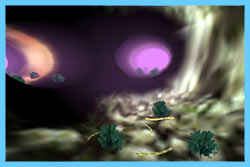 VILLAGE
- bestows visual and sound qualities during navigations and immersion
in a virtual reality snakes'landscape. VILLAGE
- bestows visual and sound qualities during navigations and immersion
in a virtual reality snakes'landscape.
TERRARIUM
explores the control of artificial life. The web environment allow us,
by using the database and algorithms'behaviors, to provoke, share and
control life exploring the unless and seamless of telematic systems.
Concerning artificial life, by linking DNA sequences from species of
snakes, we generate virtual creatures. The replication of another snake
as a clone of memes is automatically sent to any other machine, as well
the creatures created by the combination cross-over can be replicated
in other machines. The organic simulated behavior of the environment
is controlled linking simulated heat and dynamics, artificial food and
lifetime.
|
|
|
|
|
OUROBOROS
TERRARIUM,2002. Artificial life.
|
OUR
HEART, a virtual reality immersive installation, offers a virtual 3D
environment where human/technology's dialogues using heartbeats generate
graphic and sound landscapes. The immersive experience inside a cave
with stereocopic eyeglasses, capture motion system and heart beats capture
systems is linked to inputs read from the 3D tracker and presented in
the glasses. When interacting the biological heart waves translated
into electrical signals are turned into computer paradigms providing
body/machine intimate digital dialogue. The system is a responsive environment
and the interfaces offers also a proprioceptive correspondence during
immersive interactions.
I
hope I have presented some conceptual issues of interactive art. The
central issues are the complex existence in the art process, the structural
copulae between the biological and the artificial, the most intensified
possibilities to signals processing by capture and translation, the
simulation of life in virtual environments working with evolution, dynamic,
virtual meetings, remote actions, natural phenomena, among other situations
that create environments with life of themselves. I would like manifestate
the expressive capacity of technologies to feed the human sensitive
field. by acting at poetic and psychological levels, offering to the
body some rituals by performances to be accomplished in couplings with
machines in structural copulae, in a biologic and technological context.
Artists are accepting Duchamp's proposal: to put art closer to life.
That condition enhances the challenges to create more and more interactive
systems mixing animal, human, plants, cosmos signals with the technological-virtual.
In that way, we will be providing complex interaction between organic
and inorganic, natural and artificial, real and virtual.
Integrated
Research Group 2002:
NEW TECHNOLOGIES IN VISUAL ARTS - ARTECNO- UNIVERSITY OF CAXIAS DO SUL
/ CNPq. Technical team 2002: Prof. (PhD) Diana Domingues (coordinator);
Arts and Communication: Eleandra Gabriela Cavalli IC UCS; Maurício Vazquez
PIBIC CNPq; Technical and communication support: Solange Rossa Baldisserotto
- AT CNPq and Elisabeth Bianchi UCS; Computer Science: Gustavo Brandalise
Lazzarotto (leader programmer) IC CNPQ; Mauricio Passos PIBIC CNPQ;
Gelson Cardoso Reinaldo (programmer) UCS– Renato Marangon IC CNPQ; Geovani
Pandolfi IC CNPq.
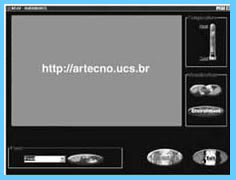
*
Diana Domíngues (PhD) is Art Professor at New Technologies
in Visual Arts, University of Caixas do Sul diana@visao.com.br
Notes
1
Edmond Couchot, expert in interactive art, includes in art discussion
the "sujet appareillé" and the "sujet interfacé" where the technical
apparatus change art process. See Couchot, Edmond. "La Technologie
Dans L'art de la photographie à la réalité virtuelle". Éditions
Jacqueline Chambon: Nîmes, 1998.
2
Varela, Francisco, "Il reincanto del concreto". In: Capucci
Pier Luigi, " Il Corpo Tecnologico, l'influenza delle technologie
sul corpo e sulle sue facoltà", Bologna,Baskerville, 1994.
3
See Roy Ascott, ideas about interactive art.
4
ESCOBAR, Ticio. "La Maldicion de Nemur". Departamento de Documentacion
e Investigaciones, Centro de Artes Visuales/Museu del Barro,
Imprenso en Imprenta Editorial Arte Nuevo, Asunción - Paraguay,
1999.
5
"Snakes 32" is a software developed by the Computer Science
fellow in Artecno team, Gustavo Brandalise Lazzarotto IC CNPq
and Gelson Cardoso Reinaldo.
6
Sounds of native rituals and natural noises remind us of primitive
ceremonies in which the human desire is to embody animals.
7
Ouroboros has been invited and participated at the 25 Bienal
Internacional de São Paulo, NET ART, curated by Christine Mello
and Rudolf Frieling http://artecno.ucs.br/ouroboros
|
Bibliography:
Anders, Peter (1999): "Envisioning Cyberspace - Designing 3D Eletronic
Spaces". McGraw-Hill, The United States of America.
Ascott,
Roy (1995): Le retour à la Nature II. In: Poissant, Louise. L'Esthétique
des Arts Médiatiques. Presses de l'Université du Québec, Québec.
--(2001):
"The instrumental poetic of Diana Domingues". In: Catalogue INS(H)NAK(R)ES.
Ed. Lorigraph: Caxias do Sul. Bigus, Joseph P. and Bigus, Jennifer (1998):
Constructing Intelligent Agents with Java - A Programmer´s Guide to
Smartes Aplications. Published by John Wilwy & Son, Inc., Canadá. Couchot,
Edmond (1998): La Technologie Dans L' Art - De la photographie à la
réalité virtuelle. Éditions Jacqueline Chambon, Nîmes.
--(1998):
"Entre La Transe et L'algorithme. In: catalogue of the exhibition Domingues,
Diana, TRANS-E , My Body, My Blood, Lorigraph: Caxias do Sul. Damer,
Bruce (1998): Avatars! Exploring and Building Virtual Worlds on the
Internet. Ed. Peachpit Press. Domingues, D. Art Interactif, corps couplé
et sentiment post-biologique. In: SOULAGES, F. (Ed.)(2001): Dialogues
sur l'art et la technologie. Autour d'Edmond Couchot. Paris: L'Harmattan.
--Diana.
"The Desert of Passions and The Technological Soul" - In: Digital Creativity,
Vol., Nº.1, Swets & Zeitlinger, Plymouth, 1998 p 11-18.
--(Ed.)
(1997): A Arte no Século XXI: A Humanização das Tecnologias. São Paulo:
Ed. Unesp.
--"Cibercultura,
creación y interactividad". In: De la pantalla al arte transgénico.
La Ferla, Jorge ( Ed.) Libros del Rojas, Buenos Aires, 2000. Escobar,
Ticio (1999): "La Maldicion de Nemur". Departamento de Documentacion
e Investigaciones, Centro de Artes Visuales/Museo del Barro. Editorial
Arte Nuevo, Asunción, Paraguay. Jones, Stephen (2000): Towards a Philosophy
of Virtual Reality: Issues Implicit in "Consciousness Reframed". In:
Leonardo, volume 33, Number 2. 2000, MIT Press.
Lovejoy,
Margot (1997): Postmodern Currents - Art and Artists in the Age of Eletronic
Media. Simon & Schuster/A Viacon Company, Prentice Hall, Upper Saddle,
New Jersey.
Machado,
Arlindo (2000): El Paisaje Mediático -Sobre el desafío de las poéticas
tecnológicas. Ed. Libros del Rojas, Universidad de Buenos Aires. Poissant,
Louise (Ed.) (1995): Esthétique des Arts Médiatiques. Presses de l'Université
du Québec, Montreal.
Saillot,
Isabelle (1993): Block -Notes, sobre "Línscription corporelle de l'esprit",
Varela Francisco, Thompson Evan e Eleanor Rosch, Seuil, Paris. In"Block-Notes,
Art et Nouvelles Technologies, L"Aventure Humaine, Savoirs, Libertés,
Pouvoirs, 3/4, Paris,1995. Teixeira, João de Fernandes (1998): Mentes
e Máquinas. Porto Alegre, Artes Médicas.
Stuart,
Russel and Norvig, Peter. (1995): Artificial Intelligence, A Modern
Approach. Prentice Hall, Englewood Cliffs, New Jersey. Varela, Francisco,
"Il reincanto del concreto". In: Capucci Pier Luigi, Il Corpo Tecnologico,
l'influenza delle technologie sul corpo e sulle sue facoltà. Bologna,Basrkerville,
1994.
|

